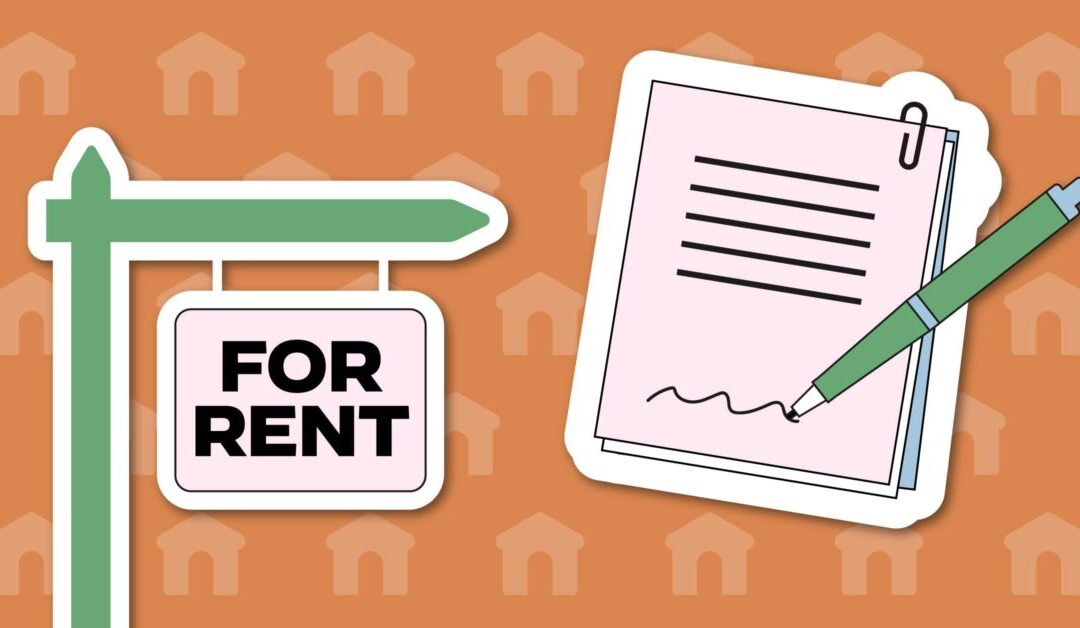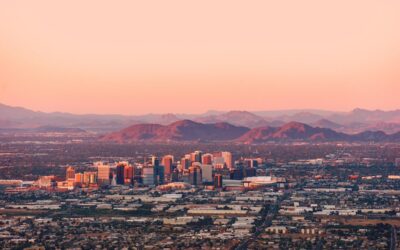
The vacant site where La Victoria Commons is set to be built in Tempe, pictured on May 28, 2024. (Photo by Alyssa Bickle)
The city of Tempe is redeveloping a handful of vacant parcels, with affordability in mind.
Apache Boulevard in Tempe is undergoing quite the change in landscape—thirty overall sites are planned for residential or mixed-use development, and nearly half of them have obtained a building permit or are already under construction.
Four of these sites are owned by the city of Tempe and incorporate a requirement that a share of housing units must be affordable, meaning that the occupant does not pay more than 30% of their gross income on housing costs.
According to data from 2010-2014, nearly 37% of households in Tempe spent more than 30% of their gross monthly income on housing costs.
RELATED: Maricopa County, El Mirage partner to make 5 homes more affordable
While the area is notably changing, the development that is underway is for the better, said Phil Amorosi, co-chair of Citizens for Vibrant Apache Corridor (CVAC), an independent community organization.
The Apache corridor is a rough three-mile stretch along Apache Boulevard between Rural Road and the Tempe Canal near Price Road, including the half-mile radius to the north and south.
“The new development just needs to be respectful of the people that live there,” Amorosi told The Copper Courier, “and then the people that live there, they need to be involved in the fact that nobody lives forever.”
What’s being built?
The city of Tempe is currently redeveloping four parcels of city-owned land along the Apache corridor: at Apache and Dorsey Lane, Lemon Street and Dorsey, and two projects near Apache and Price Road—adding 500 affordable units to the city upon completion.
The developments are part of the city of Tempe’s Hometown for All initiative, approved by the Tempe City Council in January 2021. This created a funding stream dedicated to affordable housing projects that comes from permitting fees paid on every new development project built in Tempe. Those fees are funneled into the city’s general fund supporting the Tempe Coalition for Affordable Housing.
On top of this dedicated funding stream, the Tempe City Council approved a $32 million bond on April 25 to increase its supply of affordable housing, to send to voters on the Nov. 5 ballot.
To make progress on affordable housing, Tempe Mayor Corey Woods told The Copper Courier, the city had to be in the market of going out and acquiring land and finding ways to reuse it, because Tempe is landlocked with no ability to grow out.
RELATED: Biden proposes actions to address housing shortages and high costs
“The city doesn’t have a profit motive. We’re here just to provide a good community and to provide the services that people care about,” Woods said.
One project, La Victoria Commons, on the northeast corner of Apache and the Price 101 Freeway, will include 104 apartments for rent in a four-story building, financed by Low Income Housing Tax Credits and developed and operated by Copa Health Inc.
The same complex will have 19 townhomes for sale at the back half of the property at below-market purchase rates developed by Newtown Community Development Corporation.
The homes will be part of Newtown’s Community Land Trust. In this case, Newtown uses grant funds to build a home, then sells the home to a qualified low-income buyer at a below-market value. Newtown retains ownership of the land in the community land trust and leases to homeowners through a low-cost, 99-year renewable lease.
This keeps the home affordable in perpetuity—when the buyer wants to leave, they sell the house back to Newtown, who then sells it to another low-income individual or family, continuing to help other families struggling to purchase a home in the market, said Stephanie Brewer, executive director of Newtown Community Development Corporation.
Newtown and Copa Health are partnering to complete the two separate projects faster, at a more affordable rate than either organization could have done on their own, said Brewer.
Newtown has been located in Tempe since 1994 and has worked with the city on other affordable housing projects on homeownership opportunities for low-income families and individuals.
“Nineteen units isn’t going to solve our housing crisis,” Brewer said. “But zero is not solving it either. For those…people that are going to move into the apartment complex, it’s going to make a big difference in their lives.”
Apache Central Center and EnVision Center
The city’s highlight of development along the Apache corridor is an eight-acre development located at the northeast corner of Dorsey and Apache and southwest corner of Lemon and Dorsey, the Apache Central Center.
The city of Tempe purchased the site for $10.7 million in December 2021, after the Food City closed and left the residents in the area without a close grocery option, creating a food desert.
The development will include 400 housing units, with at least half being priced for people with low-to-moderate incomes. The development will also include a new grocery store, and it is planned to open in about three years, once a developer is selected.
Much of this investment is geared towards building higher-density housing that can accommodate ranges of affordability close to modes of transportation, Ryan Levesque, Tempe’s deputy community development director for planning.
Close to the future Apache Central Center, the city will open the EnVision Center in 2024 , located at the northeast corner of Dorsey and Apache.
The space will include a resource center and resilience hub with a heat relief location, and year-round programs and services such as technology classes and parenting programs.
“We don’t need a huge return on investment. We don’t have to make profit for our investors or our shareholders,” Woods said. “I think that our best days are right in front of us.”
Looking to the future
Amorosi, the co-chair of CVAC, also sees bright days ahead, a result of his work to facilitate what he feels is good development that matches what the community surrounding the Apache corridor wants and needs.
Amorosi has long been involved with development changes in the Apache corridor. He has lived in the Hudson-Manor neighborhood near Apache and Dorsey since 1985 and has primarily worked to make sure the area doesn’t get over-developed and keeps its original feel.
He has been a voice for the neighborhoods on the city’s Development Review Commission and as the chairman of the Hudson Manor Neighborhood Association for 25 years.
In 1996, the Apache Boulevard Project Area Committee (APAC) was formed by the city of Tempe, which Amorosi became chair of in 2001.
APAC was a collaboration of neighborhoods, businesses, and the city to promote desirable reuse of land in the area and encourage community involvement and engagement.
It was originally started once the Apache corridor’s residents felt the effects of disinvestment and underutilized vacant land as businesses left the area and crime went up.
Once the Valley Metro light rail had been planned to go through the Apache corridor and Amorosi thought the area was going in the right direction, he dissolved the group in 2008.
But, Amorosi was dissatisfied with the way new development was progressing, and he started CVAC a few years later, unaffiliated with the city.
CVAC makes sure that new development blends in with the environment while taking into consideration the older, established single-family neighborhoods, and scaling down the projects in close proximity to those areas.
“You want to get such a density there, but at the same time, you want to respect the look and the feel of the neighborhood,” Amorosi said.
As improvements along Apache progressed, Amorosi was always part of the small details around development, such as widening bike lanes, and pushing for greater connectivity, like where light rail stops should be located.
For now, Amorosi and CVAC continue to work with developers who want to build in the Apache corridor, making sure no 21-story building ends up looking into his backyard.
“You can’t stay the same,” Amorosi said. “If you’re staying the same, you’re dying.”
Support Our Cause
Thank you for taking the time to read our work. Before you go, we hope you'll consider supporting our values-driven journalism, which has always strived to make clear what's really at stake for Arizonans and our future.
Since day one, our goal here at The Copper Courier has always been to empower people across the state with fact-based news and information. We believe that when people are armed with knowledge about what's happening in their local, state, and federal governments—including who is working on their behalf and who is actively trying to block efforts aimed at improving the daily lives of Arizona families—they will be inspired to become civically engaged.


Tips on how to avoid rental scams in Phoenix
If you’re searching for a place to rent, you should be aware of rental scams. Many people looking for a quick buck will make up a listing, make a...

The 4 best areas to rent in Phoenix if you don’t have a car
Although Phoenix isn’t known for being a truly walkable city like New York City or San Francisco, pockets of the Valley of the Sun are walkable. If...

Want to peek inside Phoenix’s historic homes? This tour is for you
The F.Q. Story Historic Neighborhood has been hosting the Home Tour and Holiday Street Marketplace for 38 years, allowing the community to...

Window shopping: Interesting rental listings we found in Phoenix this week (Dec. 3)
Are you looking for a new rental in Phoenix? Here are some interesting listings we found this week. This section appears in Rent Check PHX, a...





